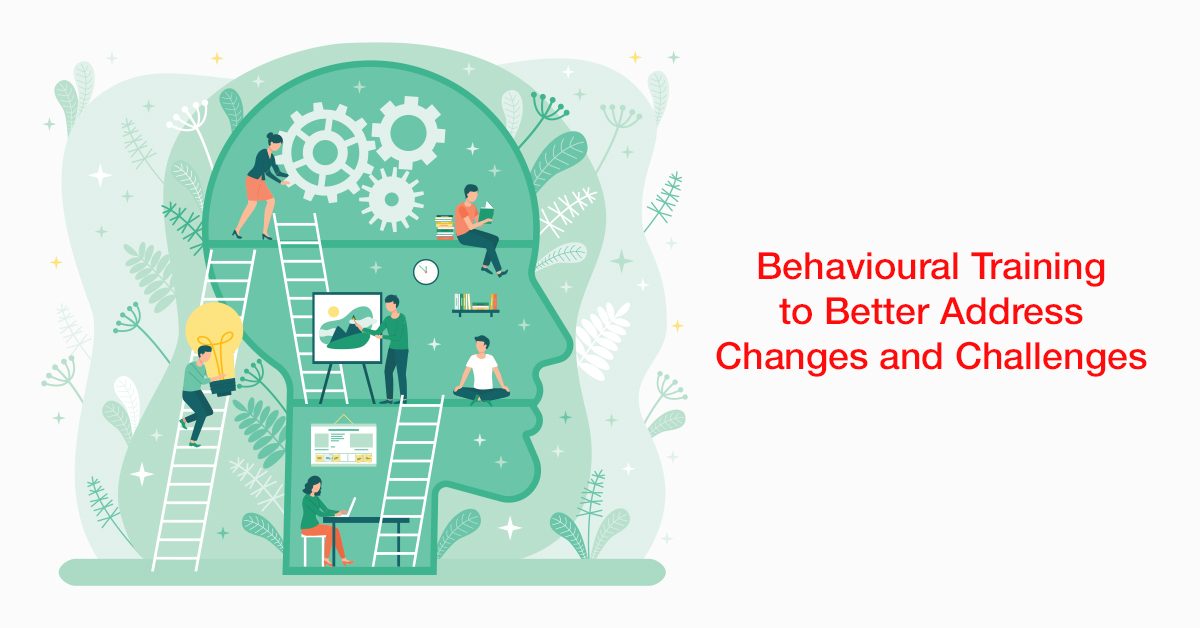
Virtual instructor-led training is a great way to train employees in a virtual-classroom setting using online learning assets. It’s all about saving costs of time, efforts, and money, by connecting instructor and learner virtually in real time. It’s a way to bring the subject matter experts to your remote learners with minimal efforts.
Getting it right is important because an ill-executed VILT session is no better than classroom training. Moreover, it may also put off your learners from attending future VILT sessions. Hence, execution is critical and so we have put together five tips on successfully developing and executing a good VILT session and learning strategy.
Why Invest in VILT?
VILT Supports Social Distancing
Under normal circumstances, social distancing is a concept unheard of. However, these are not normal circumstances and social distancing is an unfortunate reality. The ramifications of conducting traditional ILT-based events in light of the current crisis are severe, even posing several health safety and judicial concerns. ILT and its allied concepts cannot be practiced to safeguard human life and avoid offences.
VILT is the only available viable solution. Trainers and student interactions are still possible albeit over a learning management assisted by eLearning courses. In many ways, introducing and centralizing VILT as a standard training format will bring many advantages as well, and this is something businesses will realize as they start embracing VILT.
It Is Cost-Effective to Invest in VILT
Traditional instructor-led training (ILT) activities involve physical trainers, travelling learners, and cost of the venue. Some additional costs are those of energy, time, and efforts of those who attend, plan, and conduct the activity. With so many associated costs involved, ILT sessions are considered cost-intensive activities. Moreover, the extensive nature of planning and organizing an ILT session discourages organizations from hosting the same session once again.
On the contrary, VILT sessions are conducted over learning management systems. This means the cost of traveling trainers and learners, and the cost of renting a venue are avoided. In fact, training once conducted over the LMS is also recorded for future use which makes VILT sessions an overall cost-effective option.
VILT Is Scalable as it is Tech-Dependent
The limitations of ILT also extends to its highly static nature. Once a venue and budget for traveling learners are finalized, it is very difficult to account for additional learners because of the limited seating capacity of the venue and mode of transport. However, VILT is scalable, additional learners are included in the training program by simply purchasing additional webinar seats which in most cases are unlimited. Conducting an expensive ILT for just a few learners makes no sense. On the other hand, the number of learners attending a VILT session is not a problem. In most cases, the resources needed to host the training is the same.
Scalability of VILT is not limited to merely the number of learners or size of the training program. The ability to easily update, renew, and publish course materials makes VILT scalable as well. ILT is a one-time affair in most cases. The ability to update learners or intimate them about new development brought by changes with time is non-existent. VILT, however, can achieve this with ease. Theoretically, VILT once conducted, recorded, and hosted on an LMS can forever be accessed by learners and authors or trainers can update the information within the VILT session if needed.
VILT Increases Productivity and Learner Participation
ILT sessions, because of its archaic practices, has very few benefits to offer. Most people have an active attention span of 15 – 45 minutes at the most. ILT sessions that stretch past the 45-minute mark seldom have any positive effects on the learners. Most training content is not understood or captured by the learner’s faltering attention span. To add to this, ILT cannot be repeated either because of its cost-intensive nature. As a result, learner participation and subsequent productivity are hampered.
Instead, VILT sessions are carried over learning platforms which learners attend from the comfort of their homes. This automatically increases the learner’s attention spans and engagement levels. Most importantly, every session is recorded for learners to access at their preference.
Tracks Learner Performance
ILT sessions are activities where learners are handed paper-based assessments that instructors manually assess at the end of the session. Such practices have long been proven to be inefficient. Moreover, storing these assessments and deriving long-term actionable data from them is difficult and time-consuming. Instead, VILT sessions harness the power of an LMS and are better equipped at conducting assessments and analyzing responses to determine the success of training programs. Moreover, these results are stored on the LMS which process the data over extended periods to derive long-term actionable data that L&D teams can use to streamline the development process.
Supports Continuous Training
The ability to conduct ILT is dependent on many external factors which the L&D and learners may have very little control over. For example, the availability of a travelling trainer or the venue itself. Even the ability for all learners to make it to the training venue on a given day is very low, chances are some may never make it for reasons unknown.
However, VILT brings this probability of uncertainty down by more than half by removing more than half of the factors that an L&D team may have very little control over. The need to travel, rent a venue, and accommodate travelling learners is non-existent, thereby simplifying and negating the complicated logistics of hosting an ILT session. This fortifies the fact that VILT is a form of nonstop training which is easy to conduct thanks to fewer variables and barring some major breakdowns, hosting a VILT session with ease, every time, should not pose a challenge.
Increases Diversity and Inclusion
VILT sessions online presence enables a wide group of people to attend training from across the globe. It presents organizations with an assortment of trainers to choose from without worrying about paying for the trainer’s traveling and accommodation costs along with the general training fee. Moreover, training is accessible to people with physical impairments as well which is an added advantage of remote training.
Here are 5 Tips to Keep in Mind When Planning a Virtual Instructor Led Training Session:
Define Goals
A VILT session can mean a literal ILT session hosted over a learning management system or webinar tool. Subsequently, It can also be more than just an evolved form of ILT.
It is your call to make, and whatever the call may be, you need to define a set of goals that the VILT session must accomplish.
Goals can revolve around the outcomes of the training or even the kind of training you want to deliver. Goals are defined for the course curriculum or even the design of the eLearning courses being used. Setting a goal for any of the supporting functions of VILT in advance helps give shape to your program. It also allows you to deliver a session with greater results.
Some other goals to set when planning virtual instructor led training are:
-
What should all learners leave the session with?
-
Who are the type of learners that must attend the session?
-
Is the use of eLearning media heavy or minimal?
-
Should it simply simulate a traditional classroom, or should it be unique because VILT offers the chance to do so.
Defining goals in advance will help you plan a good virtual instructor led training session. So, take the time to think it through and define goals to work towards.
Select the Right Platform and Partner
VILT is carried out over a digital platform. The two most common options are webinar tools or an LMS integrated with webinar tools. Under simple circumstances, a webinar may just do the job.
However, for corporate training, a webinar is just too basic. Corporate training requires the prowess of a learning management system integrated with a webinar tool.
Such LMSes allows you send invitations, set calendar reminders, take attendance, generate reports, conduct webinars, and most importantly support the training in three essential stages.
The Three Stages of VILT are:
Pre-training
Learners access the LMS for pre-training content and introductory topics in this stage. It’s the best way to get up to date on the basics of a subject allowing the trainer leading the session to quickly jump into the core of the training without spending precious energy or concentration on explaining basics.
Mid-training
VILT allows trainers to push supporting content while the training program is underway. Trainers share links, PDFs, documents, audio, or any other media with learners to deliberate on topics. It can even be a small presentation or a group of slides to engage learners midway through the training program.
Post-training
An LMS is perfect for conducting assessments and providing analytics to trainers. These reports help trainers understand if learners successfully understood the training or is more training needed. Analytics helps trainers to plan future programs and make changes to existing ones to increase participation and learner outcomes, thus making the training program a success.
Include Engaging eLearning Media
Instructor-led training can seem plain and uninspiring because of the lack of engaging media used to capture the learner’s imagination. This, however, is not the case with VILT. An LMS with VILT allows trainers to host engaging eLearning media on the LMS for learners to access.
In most cases, this content can touch upon areas that the actual trainer may not want to, either because of the shortage of time and learner attention spans or the complexity of the subject being so high that supporting images and media together are needed to explain the topic.
Instructional designer can break VILT into three components, all of which require eLearning and supporting media to a certain degree. As a result, well-designed media will do great justice in such instances.
Integrate Polls and Surveys into VILT Programs
VILT sessions present a great opportunity to integrate polls and surveys aimed at learners. It encourages them to share ideas and opinions on what they feel about the training received. These opinions are crucial to trainers looking to improve future training sessions and even help current learners with problems they may be facing.
Polls and surveys are great at engaging learners as well. Placing them strategically at intervals in the training program gives learners a chance to interact with the training program and re-engages those that may have lost track of the training.
The LMS stores surveys and responses collected during VILTs for future reference, unlike the paper-based surveys carried out during regular ILT. Moreover, trainers do not have to compile the answers to derive meaning as the LMS’s analytics engine compiles them.
Integrate Mandatory Q&A Sessions
Like regular ILT, VILT must also make space for trainer and learner interactions in the form of Q&A because such learning experiences are what makes ILT sessions a learner’s preferred training activity.
However, VILT allows for greater possibilities as compared to ILT. Learners can drop questions to the trainer during VILT sessions which are stored and replied to by the trainer personally either during or after the training session. The fact that trainers can respond to every question is what makes VILT better than regular ILT where the shortage of time may not permit the trainer to address every question.
Hence, Q&A segments are an integral part of the VILT session, and you must make space to account for such an activity to ensure that learners get a chance to interact with trainers and work on solving doubts.
Advantages of Implementing VILT for New Adopters
-
Social Distancing
-
Cost Saving
-
Scalable
-
Increased Learner Participation
-
Trackable Learner Performance
-
Nonstop Training
-
Increased Diversity and Inclusion
We have covered this topic in greater detail in our article titled Why Should You Invest in VILTs. Visit the link to read all about it.
Our Process of Designing and Implementing VILT
Course Outline and Structuring
We start with analyzing your classroom training and structuring it to fit into logical, smaller learning chunks. Outlines define a course’s logical flow like a blueprint. They ensure that learners are methodically introduced to new topics or assessments at strategic intervals, maximizing learning retention. Good eLearning courses always account for flow and logical structuring to maximize their impact.
Modern Instructional Design to Promote Engagement and Collaboration
We have a team of experienced instructional designers whose primary role is to make your courses engaging. They study your content and build a course outline to break down content into more digestible chunks. They then proceed to add life into each of the courses, using modern theories and proven delivery approaches. From the tone of the narrative to the images, colors, and illustrations, our instructional designers will take your content up a few notches.
Scripting with Accommodation for:
Opinion Polls
Our instructional designers create the script keeping in mind engagement and knowledge transfer with no place for distraction and digression. Opinion polls gather responses like opinions from the learners. These polls help with assessing learner outlook on the subject matter and preferences as well.
Surveys
Surveys are like opinion polls, but unlike opinion polls which can be learner specific in some cases, surveys are used to assess the consensus of a group of learners on a given topic. It is a study of collective opinions to understand a broader outlook of learners.
Discussions
Since the course is designed to assist with instructor-led training, our IDs place strategic discussion segments along the way to ensure that learners are drawn into the course by allowing them to ask questions and hold free or regulated discussions regularly with the trainer.
Microlearning Modules
Research indicates that learners prefer training content broken into micro-sized modules (5 – 10 minutes) that stick strictly to the script and deliver all the information needed about a topic within the limited time-period and while the learner’s interest and attention span is peaked. Microlearning is a widely used concept and our IDs highly recommend including them.
Audio Visuals
Course modules need a little bit of everything to engages learners. Relying solely on text and images to deliver an impact can impair and take away from a good eLearning course. We also have a team of experienced video developers who use the best tools to produce video-based training with engaging animations, graphics, and voice-over to give your course an added edge.
Case Examples
If a topic can be explained using case studies and examples, it makes a greater impact on learners. We collect all the needed intel on real impacts your organization had on other’s lives in relation to your training content and weave them into the course to make an impact. Real-life examples are the best training tools.
Scenario-Based Questions
Placing learners directly into the environment of a training topic encourages them to think critically. We encourage scenario-based questions and recommend including them in your training. We do the thinking and framing of scenarios that are engaging and evoke the imaginations of learners and include them on a more psychological level.
Open-Ended Questions
Open-ended questions are another way to engage learners. By not limiting a learner’s response, open-ended questions encourage learners to participate in the training activity and provide a more detailed response on their outlook on a certain topic. It also helps to assess a learner’s understanding a subject in detail.
Additional Support Material
We always recommend the inclusion of additional reference materials that learners can use to reinforce the topics already covered in the course. Learners download this additional support material as they progress through the course.
Additional content materials like documents, videos, and links enhance the training experience. We collect such additional reference material from clients and perform basic structuring and designing work on them to make it presentable as a part of the course. At eNyota, we never cut corners.
Tool Agnostic Approach
We do not believe in the one-size-fits-all concept because each eLearning output is different based on the needs and learner preferences. Hence, we never shy away from taking up a project using any of the popular authoring tools available in the market. Our IDs use all popular tools. Their designs are based on your needs.
Can We Help Plan Your VILT Program?
Yes! eNyota Learning has over 13 years of experience in working with organizations to set up and launch their VILT programs and similar training courses. If your organization is looking to implement VILT solutions in order to cost effectively deploy remote training, reach us by filling a contact form and we’ll reach out to you!








